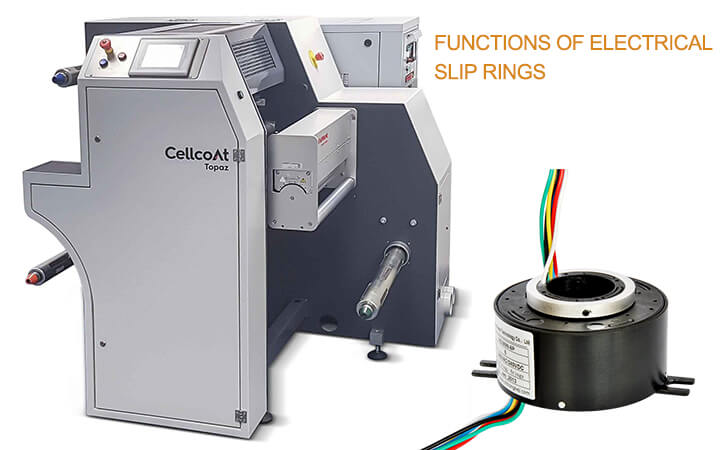A slip ring is a type of electrical connector that allows the transmission of power and electrical signals from a stationary to a rotating structure. The function of slip ring has been harnessed to interconvert various forms of energy. Slip rings are commonly used in a variety of applications where there is a need to transmit power or signals between stationary and rotating components, such as in electric motors, generators, and actuators. They can also be found in rotating machinery and equipment, such as cranes and robotics.
- Function of slip rings explained!
- Recent advancements in slip ring technology
- How to figure out a low-quality slip ring?
Function of slip rings explained!
Slip rings can be used to transmit a variety of electrical signals, including power, data, and control signals. The function of slip ring is due to the appropriate raw materials used. They are typically made of copper or other conductive materials and may be coated with a protective layer to reduce wear and improve performance.
There are a few different types of slip rings, including brush-type slip rings, carbon-brush slip rings, and fiber-optic slip rings.
Brush-type slip rings are the most common and use physical brushes to make contact with the conductive rings. Carbon-brush slip rings use carbon brushes instead of metal brushes, which can reduce wear and improve performance. Fiber optic slip rings use optical fibers to transmit data and control signals and do not require physical contact between the stationary and rotating components.
Slip rings function can be outsourced to various industries. Some notable facts about these are:
Slip rings can be made from various materials, including copper, bronze, and carbon. The material used depends on the specific application and the type of current being transmitted.
They can be designed to transmit high or low power, depending on the application. For example, slip rings used in wind turbines may need to transmit high power to drive the generators, while those used in medical equipment may only need to transmit low-power signals.
Slip rings are often used in combination with brushes, which make contact with the rings to transmit the electrical current or signals. The brushes wear out over time and need to be replaced to ensure reliable transmission.
Slip rings can be customized to meet specific requirements and can be designed to be resistant to extreme temperatures, high speeds, and harsh environments.
They are used in a wide range of industries, including aerospace, military, marine, transportation, and renewable energy.
Recent advancements in slip ring technology
The future of slip rings is likely to involve the development of new technologies and materials that enhance their performance and reliability. For example, research is being conducted on the use of new materials, such as carbon nanotubes, which have high electrical conductivity and are resistant to wear. In addition, regarding slip ring function, there is a trend towards the development of slip rings with higher operating speeds, higher current ratings, and increased resistance to environmental factors such as dust, moisture, and temperature fluctuations. Thus the function of slip ring is taken to a whole new dimension.
The integration of the function of slip rings and split rings is also a futuristic aspect that can help to improve the efficiency of many devices if executed more properly.
Other areas of focus for the future of slip rings include the development of more compact and lightweight designs, as well as the integration of additional functions such as data transmission and sensing capabilities.
Overall, the future of slip rings is likely to involve continued innovation and the development of new technologies that enable these devices to meet the evolving needs of a wide range of applications.
If a slip ring is functioning improperly, it can lead to a variety of problems depending on the specific application in which it is being used. Some potential issues that may arise include:
Loss of power or signal transmission: If the slip ring is not functioning properly, it may not be able to transmit power or signals between the stationary and rotating components of a system. This can result in equipment failure or decreased performance.
Increased resistance: A malfunctioning slip ring may have increased resistance, which can lead to increased heat generation and potentially cause damage to the system.
Reduced lifespan: If a slip ring is not functioning properly, it may not be able to withstand the stresses of operation and may fail prematurely.
If you suspect that a slip ring is functioning improperly, it is important to diagnose the issue and take steps to repair or replace the component as soon as possible to avoid potential damage to the system to maintain the function of slip rings.
How to figure out a low-quality slip ring?
There are several ways to identify a low-quality slip ring. Some signs to look for include:
Poorly designed contact points: The contact points on a slip ring are critical for transmitting power and signals. If they are poorly designed, they may not function properly or may fail prematurely.
Low-grade materials: A slip ring made from low-grade materials is more likely to fail or have a shorter lifespan than one made from high-quality materials.
Unreliable manufacturer: A reputable manufacturer is more likely to produce high-quality slip rings than one with a poor track record. It is a good idea to research the reputation of the manufacturer before purchasing a slip ring.
Poorly sealed: A slip ring that is not properly sealed may be susceptible to moisture, dirt, and other contaminants, which can interfere with its operation.
It is important to carefully evaluate the quality of a slip ring before purchasing it to ensure that it will function properly and have a long lifespan in your application. We think this article would’ve given you an appropriate insight into the function of slip rings and a plethora of other important information as well. We hope to enrich your minds with more articles of the same caliber in the future.


